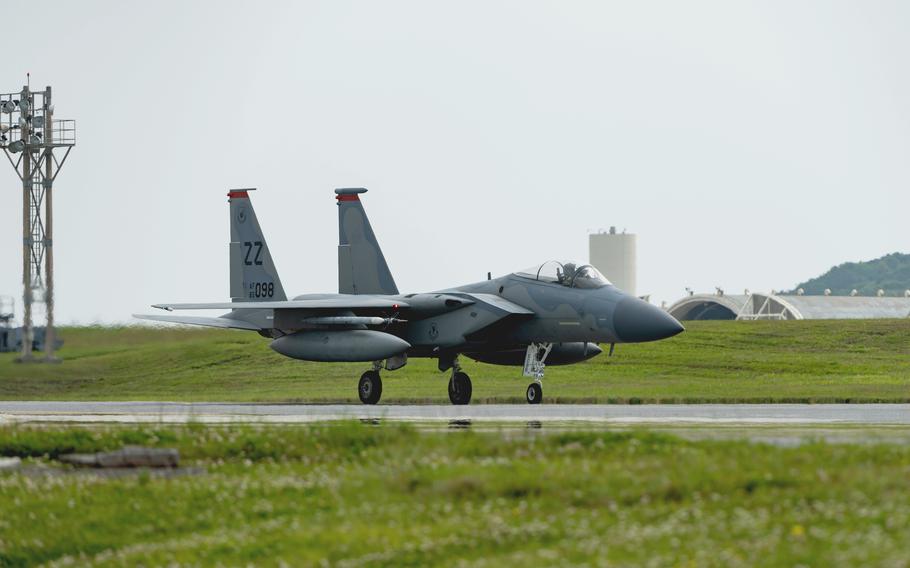
An F-15C Eagle taxis on Kadena Air Base, Japan, April 3, 2020. (Matthew Seefeldt/U.S. Air Force)
The Air Force move to replace F-15 Eagle fighters with rotating units of more advanced fighters signals awareness that Okinawan bases won’t survive a conflict with China, according to a former Marine fighter pilot and diplomat.
A two-year phased withdrawal of two squadrons flying the supersonic aircraft from Kadena Air Base, Okinawa, began Nov. 1, soon after the release of the new U.S. National Defense Strategy highlighting China as the American military’s “pacing” challenge.
“You can look at it (removal of the F-15s) as the USAF coming to grips with the reality that nothing on the first island chain, especially not Kadena, will be survivable in a conflict with China,” Steve Ganyard, a former deputy assistant secretary of state, told Stars and Stripes in an email Friday.
China’s massive military build-up includes an expanding arsenal of missiles with many of the weapons presumed to be aimed at U.S. bases in Japan. A 2017 report by Navy Cmdr. Thomas Shugart, a senior fellow at the Center for a New American Security, for example, includes satellite imagery of Chinese missile test sites that appear to mimic Yokota, Kadena and Misawa air bases.
Around a dozen F-22 Raptor jets arrived on Okinawa Nov. 4 from the 3rd Wing at Joint Base Elmendorf-Richardson, Alaska, to start a six-month rotation while the F-15s head home. The Air Force described the Raptors as “backfill” for the retiring F-15s while the Defense Department decides on a long-term plan to fulfill its obligations to Japan.
“Better to have rotational forces that might preserve an option to be redeployed, at least far more easily than permanently based forces with their families,” Ganyard said.
The Air Force is deployed with a focus on potential conflict in North Korea, a scenario in which its rear bases are presumed secure, he said.
“China changes that and puts everything south of Kagoshima (in southern Japan) particularly at risk,” he said. Marine Corps Air Station Iwakuni, south of Hiroshima, and Yokota Air Base in western Tokyo may also be targeted, he said, “if things get really tough.”
The Air Force in recent years has been training to deploy aircraft, support personnel and equipment to remote locations to operate far from comfortable home bases, a doctrine called agile combat employment.
The Navy and Marines have rotated forces through the Far East for decades, Ganyard said.
“That’s a change for the [Air Force] but if air capability improves then maybe they should have considered it earlier,” he said.
Fighter pilots on Okinawa see themselves as “on the tip of the sword,” Jay Burton, 70, of Rapid City, S.D., who flew over 1,000 hours in F-15s including at Kadena in the early 1980s, said in an email Thursday.
“We were, and had to be, prepared for combat usually associated with North Korea,” he said.
The aircraft is designed for air-to-air combat using missiles and a 20mm gun. Its primary mission is to defend against intruders entering friendly air space, but the aircraft can also protect other aircraft striking enemy territory, he said.
The Chinese will welcome the F-15s’ removal from Okinawa, retired Marine Col. Grant Newsham, a senior researcher with the Japan Forum for Strategic Studies in Tokyo said in a Friday email.
“There is simply a matter of perceptions,” he said. “When you withdraw forces from the ‘front’ it suggests weakness, confusion, etc. And sometimes just the ‘suggestion’ is enough.”
Newsham’s concerns echo those expressed by a group of Republican Party lawmakers who wrote to Defense Secretary Lloyd Austin Nov. 1 asking to be briefed on the aircraft moves.
The U.S. plan to replace the F-15s strengthens, not weakens, the deterrence quotient on Okinawa, a spokesman for the Japanese Defense Ministry said Oct. 28. Government spokespeople in Japan customarily speak to the media on condition of anonymity as a requirement of their position.
However, inwardly, the Japanese are unhappy about the F-15s removal, Newsham said. They have no plans of their own to replace them, he said.
“They don’t really have the resources even if they wanted to do so,” he said.